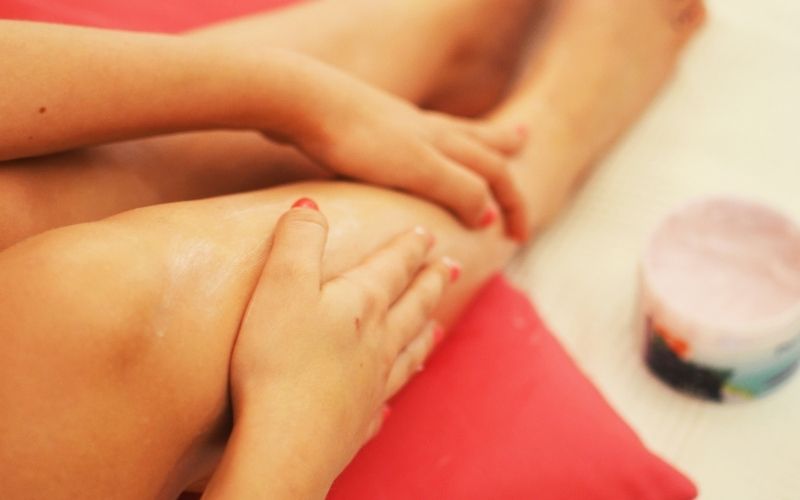Properly exfoliating your legs can unlock numerous skin benefits, ranging from minimizing the appearance of “strawberry legs” — those darkened pores or small bumps often a result of shaving or keratosis pilaris — to evening out skin tone and enhancing the skin’s overall texture.
Regular exfoliation can also significantly reduce ingrown hairs and make hair removal smoother and less irritating.
However, if you want to exfoliate your legs but aren’t sure where to start or how to do it properly, continue reading.
In this article, I will delve deeper into explaining how incorporating leg exfoliation into your skincare routine can help you achieve not only aesthetically pleasing results but also contribute to your skin’s long-term health and resilience and how to exfoliate your legs correctly for the best results and no adverse effects.

The Benefits of Exfoliating Your Legs
Exfoliating your legs is not just about maintaining the aesthetic appeal of smooth skin; it holds various benefits for skin health and overall appearance:
- Achieves Smoother Skin: By removing the outermost layer of dead skin cells, exfoliation reveals the softer, smoother skin beneath.
- Enhances Moisturizer Effectiveness: Removing dead skin cells allows moisturizers to penetrate more deeply and effectively into the skin, providing better hydration and softness.
- Prevents Ingrown Hairs: Regular exfoliation keeps hair follicles clear of cellular debris, reducing the likelihood of ingrown hairs that often occur after shaving or waxing.
- Evens Skin Tone: Exfoliation can help in fading scars, discoloration, and hyperpigmentation over time, leading to a more even skin tone.
- Minimizes Appearance of Strawberry Legs: Exfoliation can help fade the darkened appearance of pores on the legs, often referred to as “strawberry legs,” by clearing away the buildup of oil, dirt, and dead skin.
- Improves Circulation: The physical process of exfoliating can boost blood circulation to the skin’s surface, contributing to healthier, glowing skin.
- Prepares Skin for Tanning: For those who use self-tanners, exfoliating beforehand can help achieve a more even, streak-free tan by removing uneven patches of dead skin.
How to Prepare Your Legs for Exfoliation?
Here’s how to prepare your legs for exfoliation to maximize the effect:
- Choose a Gentle Cleanser: Look for a mild, fragrance-free cleanser or body wash that can cleanse without overdrying or irritating the skin.
- Use Lukewarm Water: Hot water can dry out the skin, while cold water might not effectively remove dirt. Lukewarm water is ideal for cleansing without causing dryness or irritation and softening the skin before exfoliation.
- Rinse Thoroughly: Make sure to rinse off all traces of the cleanser to avoid prolonged contact with potentially drying and irritating surfactants in the formula.
- Pat Dry: Gently pat your legs dry with a soft towel. Avoid rubbing, as this is considered a form of harsh exfoliation that can irritate the skin and cause redness and flaking.
How To Exfoliate Your Legs?
Exfoliation comes in two forms, known as physical and chemical exfoliation.
Physical exfoliation involves physically scrubbing the skin with an abrasive material to remove dead skin cells, while chemical exfoliation uses acids or enzymes to dissolve and slough off dead skin without physical scrubbing.
Choosing the right method depends on your skin type and sensitivity.
Physical Exfoliation
Physical exfoliation gently buffs away dead skin cells through a variety of methods, from soft brushes and konjac sponges to more abrasive agents like sugar or salt granules and crushed coffee beans.
While it’s often too harsh for delicate facial skin, physical exfoliation effectively rejuvenates thicker, tougher body skin.
This makes it particularly effective for legs, where it can reveal hidden ingrown hairs and leave skin smooth and refreshed.
Here are the best tools for physical exfoliation on the legs:
Brushes
Body brushes are a fantastic tool for sloughing off dead skin cells, best used on dry skin just before a shower.
For optimal results, start at the groin and gently brush down to the ankle in smooth circular motions.
It’s important to apply constant yet gentle pressure—enough to stimulate circulation without causing discomfort, scratches, or redness.
Scrubs
Despite the widespread skepticism among skincare enthusiasts online, scrubs can be highly beneficial for areas like the back, arms, groin, legs, and even the soles of the feet.
The key to leveraging their benefits is to apply them to wet skin, which allows for a smoother and more effective exfoliation process.
Using scrubs on wet skin will also help the formula glide more efficiently, reducing pressure and friction and preventing side effects such as dryness, irritation, and burns.
Sponges & Loofahs
Sponges and loofahs are convenient for shower use and can be exceptionally useful at scrubbing away layers of dead skin cells in the groin area.
Most people who shave know the groin area is a hot spot for ingrown hairs, and by removing a few layers of dead skin cells, you can help the hair come out to be removed with a razor or another hair-removal method.
However, be mindful of the pressure you apply when using sponges, as they can be irritating to the skin and cause burns and friction.
Instead, use them only in the opposite direction from the hair growth instead of scrubbing vigorously back and forth.
Gloves
Exfoliating gloves are the most convenient method of physical exfoliation, allowing for the manual removal of dead skin cells simply by wearing them and massaging the skin in a circular motion during a bath or shower.
This hands-on approach provides immediate feedback on the pressure applied, ensuring a thorough yet gentle exfoliation that can help improve skin texture, promote circulation, and prepare the skin for better absorption of moisturizers.
Furthermore, their reusable nature and ease of use make exfoliating gloves a cost-effective and eco-friendly option for maintaining smooth, healthy-looking skin.
Chemical Exfoliation

Chemical exfoliation involves applying a product containing exfoliating acids or enzymes to dissolve the bonds that hold dead skin cells together and encourage them to shed naturally.
This is a gentler form of exfoliation that is appropriate and preferred for facial use, but it can also be used on the legs due to its brightening effect that can lighten dark spots caused by pimples, ingrown hairs, shaving, etc.
Chemical exfoliation can also contribute to smoother and glowier legs with a lower risk of irritation due to the skin on the legs being thicker and more resilient.
Here are some chemical exfoliating products I use on my legs:
Cleanser
Incorporating an exfoliating cleanser into your leg care routine can significantly enhance both the look and feel of your skin.
Removing dead skin cells not only prevents the dullness and rough texture associated with cell accumulation but also reduces the risk of ingrown hairs, a common issue for those who shave or wax.
Moreover, chemical exfoliation improves the skin’s absorption of moisturizers, leading to deeper hydration and a softer, more supple feel.
Additionally, the process aids in evening out skin tone and stimulating blood circulation, contributing to a healthier, more radiant appearance.
Toner
Exfoliating toners can be particularly beneficial for addressing “strawberry legs,” a condition characterized by darkened pores or small bumps on the legs, often resulting from shaving or keratosis pilaris.
Ingredients commonly found in exfoliating toners include glycolic, lactic, and salicylic acid, which target the excess keratin and oil that contribute to this condition and help reduce the appearance of dark spots while promoting a smoother skin texture.
Regular use of an exfoliating toner on the legs can lead to clearer, more even-toned skin, effectively reducing the visual impact of strawberry legs over time.
Pads
Exfoliating pads are essentially cotton rounds soaked in an exfoliating solution.
They are similar to toners but more convenient to use since the exfoliating solution is already applied to the pad, eliminating the need for separate applications.
These pads are typically saturated with similar active ingredients found in exfoliating toners, such as glycolic, lactic, or salicylic acid, which work to gently dissolve the bonds between dead skin cells, allowing them to be easily removed.
Exfoliating pads can also be useful for reducing the appearance of strawberry legs, rough skin texture, ingrown hairs, and even active acne in areas such as the thighs and hips.
Furthermore, the convenience and ease of use of exfoliating pads make them ideal for consistent skincare routines, ensuring regular application and, thereby, more significant improvement in the skin’s condition over time.
Frequently Asked Questions
How Often Should You Exfoliate Your Legs?
Exfoliating your legs twice to three times a week is more than enough to make the skin look smooth and glowy.
Should You Exfoliate Your Legs Before or After Shaving?
Always exfoliate your legs before shaving, as this will help soften the skin and cause fewer irritations while shaving.
How To Exfoliate Your Legs With Ingrown Hairs?
Physical exfoliation is preferable for ingrown hairs, and the pressure should always be applied against the hair growth instead of making a back-and-forth motion.

My name is Simone and I am a certified skin specialist. I created this website to teach my readers how to take great care of their skin and I also like to occasionally share my honest opinions on skincare products I’ve tried. You can learn more about me here.
